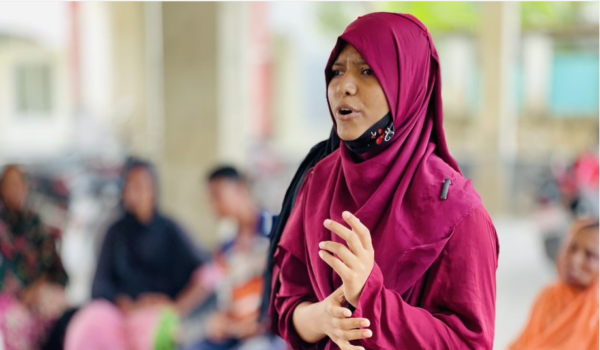Empowering Women with Disabilities through Intersectional Advocacy
This piece was co-authored by Senior IAG Advisor with CBM Australia, Teresa Lawler, and ACE Fellow Janine Cruzet. Janine works for Women with Disabilities Taking Actions on our Reproductive Health and Human Rights.
 |
 |
Image description: Left, a headshot of Teresa Lawler, Senior IAG Advisor with CBM Australia, and a headshot of ACE Fellow, Janine Cruzet.
When we talk about intersectionality, it’s not just a fancy term thrown around in academic circles. It’s a reflective concept that resonates deeply with the experiences of women with disabilities. But what does it really mean?
Imagine an exquisite embroidery, meticulously stitched from threads of race, gender, disability, and socio-economic status, each strand intricately woven into the fabric of our lives. Every thread adds its own unique colour and texture, forming a rich and complex pattern that defines who we are.
For women with disabilities, this embroidery isn’t just a metaphor—it’s their everyday reality. Their lives look like this delicate needlework, where the threads of gender and disability intersect, shaping their individual experiences.
Just as creating an embroidery requires skill and patience, navigating through societal expectations and barriers demands resilience and determination.
Their stories come together to create a beautiful and diverse piece of needlework contributing to the beauty and complexity of the human experience.
Consider Janine, a woman with a visual impairment.
Every day, she navigates a world filled with physical barriers, from inaccessible buildings to transportation challenges, as well as attitudinal barriers and biases based on both her gender and disability, which severely limit her job opportunities.
Janine faces communication barriers that make access to essential health care, such as family planning, feel like deciphering a coded message. Her journey is filled with unexpected obstacles, each reflecting different aspects of her identity, making progress a continuous uphill battle.
Zooming out to look at the bigger picture, intersectionality extends beyond Janine or any individual, it encompasses the collective experiences of women with disabilities and other disadvantaged people worldwide. It recognises that struggles stem not from singular identities or issues, but from a combination of factors.
These factors create advantages for some and disadvantages for others, depending on the context.

Image description: A woman OPD representative in Bangladesh speaks during a consultation meeting.
Importantly, intersectionality recognizes that these distinctive experiences not only shape individuals’ identities, but also develop resilience, deepen understanding and reinforce inner strength.
So, how do we translate this concept into something practical and useful for the disability movement and others? It begins by using language that resonates with everyday reality. Let’s abandon the jargon and discuss these issues in straightforward terms.
Imagine sitting down with Janine and her friends, enjoying coffee and swapping stories. Through casual conversations, you explore how their identities intersect and the effects on their lives. As they share moments of triumph and frustration, you nod in empathy because you’ve been there too.
This is not just storytelling—this is validation. It acknowledges the strength needed to navigate a world that often feels stacked against you. It says “I see you. I hear you, and your experiences are valid.”
Then, comes the real magic: weaving these personal narratives together to reveal the deeper societal issues underpinning them. Together, you recognise that these experiences are shaped by systemic discrimination – a blend of gender, disability, race and more. You brainstorm ways to challenge these injustices, from advocating for inclusive policies to building community support networks.
As we explore this process, let’s ensure we remember to be self-aware, as well. Each of us holds power or influence in some capacity; the key is to recognise it and use it to advocate for others. For instance, as a man with a disability, you may be well-placed to challenge gender stereotypes, or as a woman from the ethnic majority, you can facilitate inclusion for ethnic minorities in community decision-making spaces.
Intersectionality isn’t just a theory—it’s a roadmap to empowerment.
It acknowledges our roles as both message bearers and recipients, embracing the complexities of experience and identity, and using them as sources of strength. It’s about standing together and proclaiming, “We are here, and we demand to be heard. We demand to be seen.”
Through this collective voice, real change towards meaningful inclusion and valued participation becomes possible.
The ACE project is funded by Equity Trustees, UNFPA and CBM Australia.
https://www.cbm.org.au/iag/empowering-women-with-disabilities-through-intersectional-advocacy
Related Stories

Advent 2025: Jesus’ way leads to fullness
The way of Jesus gives people freedom and empowers them to live out their God-given purpose. The last few weeks...

Advent 2025: Preparing the way produces fruit
John the Baptist called people to prepare for God’s presence through repentance and by producing fruit (acts of justice,...

From sports to advocacy – the journey of the Isiolo Umbrella Disability Group
The Promoting Inclusive Delivery of Eye Care (PRIDE) Project is a...
